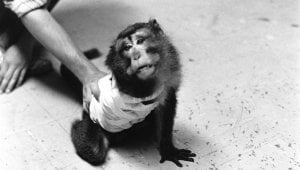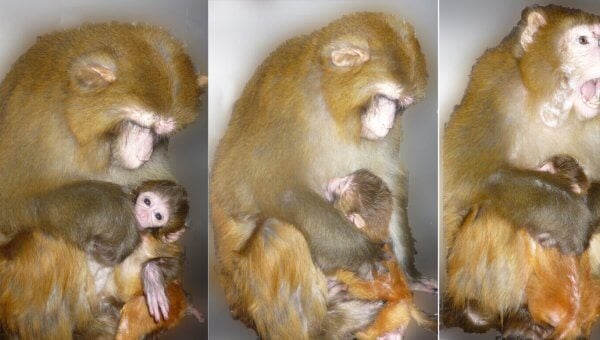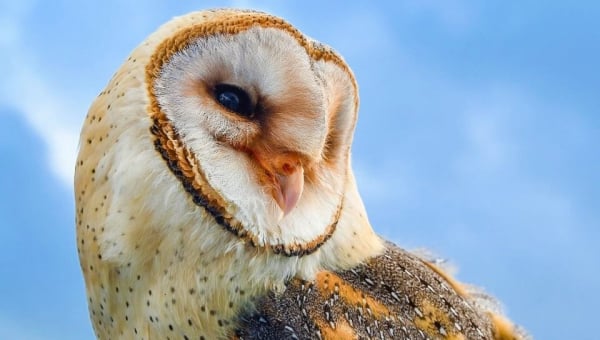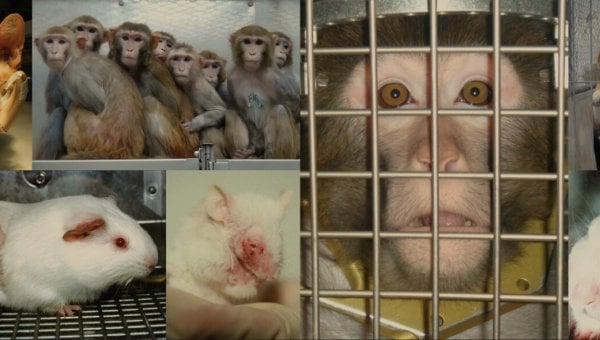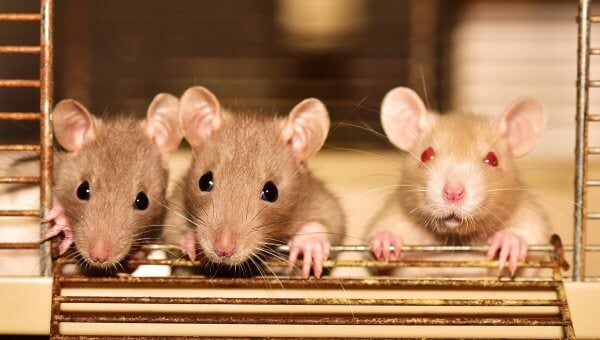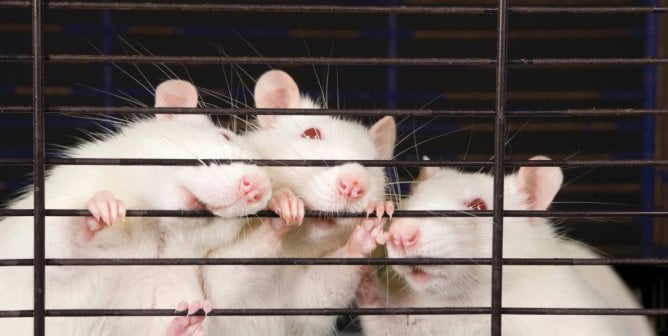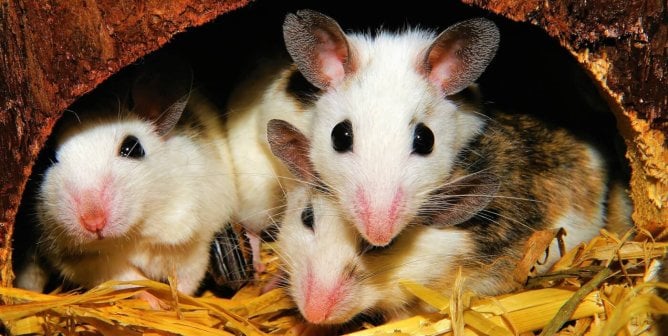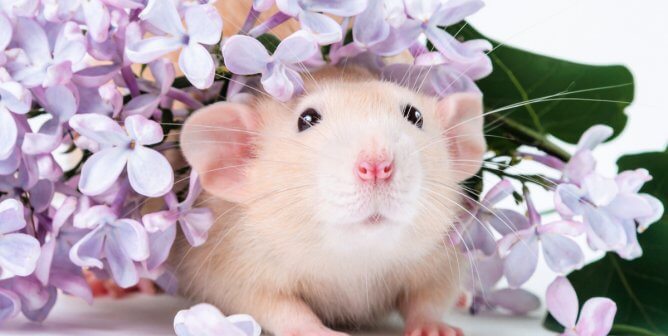A Century of Suffering: 10 Gruesome Experiments on Animals From the Last 100 Years
Mice, rats, dogs, monkeys, rabbits, and other animals have been suffering in experiments for more than a century. During the last 100 years, sensitive animals trapped in laboratories have been burned, shocked, poisoned, forcibly impregnated, decapitated, locked away in isolation from other members of their species, and made to endure countless other atrocities. Below, you can learn more about the sordid history of animal testing — including the landmark investigation that launched PETA more than 40 years ago.
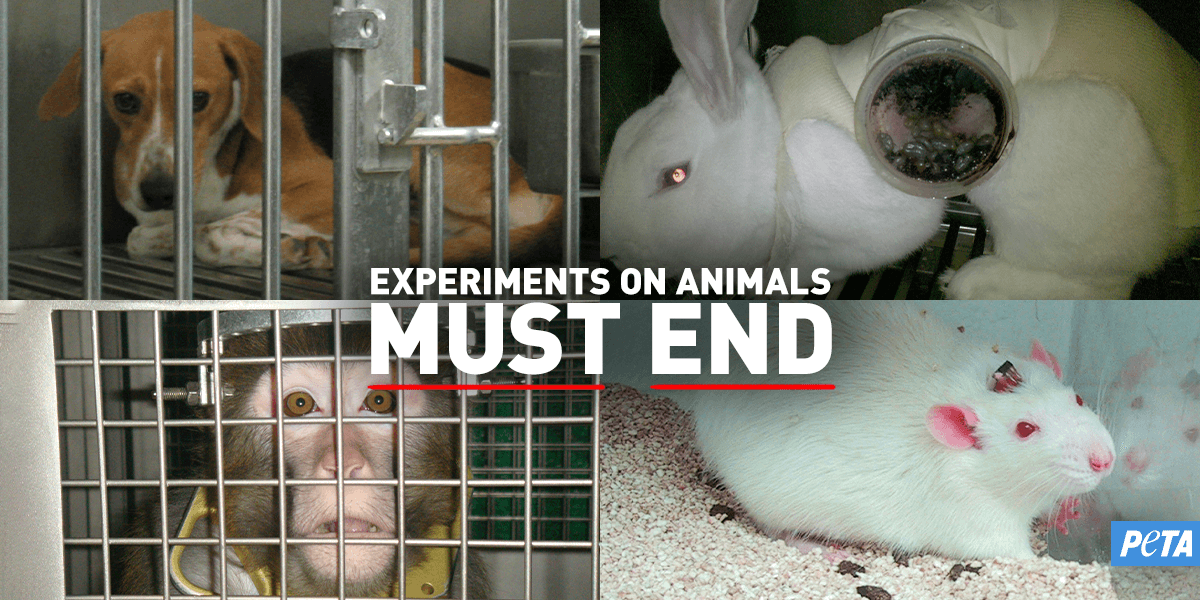
The History of Animal Testing — 10 Shocking Experiments on Animals From the Last Century
1. Maryland Psychologist Severed Spinal Cords, Repeatedly Shocked Monkeys (1958–1981)
At the Institute for Behavioral Research in Silver Spring, Maryland, psychologist and animal experimenter Edward Taub—a man with no medical or veterinary training—kept 17 monkeys in cramped wire cages that were caked with feces. The animals were subjected to debilitating surgeries in which their spinal nerves were severed, rendering one or more of their limbs useless. They were then forced to try to regain function in their impaired limbs through cruel methods such as electric shocks and pinches with pliers.
PETA’s groundbreaking investigation into this hellhole led to the nation’s first arrest and criminal conviction of an animal experimenter for cruelty to animals, the first confiscation of abused animals from a laboratory, and the first U.S. Supreme Court victory for animals used in experiments.
2. Pfizer Injects Horses With Snake Venom (1961–Present)
In Pfizer laboratories, snake venom has been repeatedly injected into 111 horses and large quantities of their blood have been drawn. These painful procedures can cause horses to fall ill, lose weight, and become anemic, and no pain relief is provided.
3. Government Experimenter Inflicts Permanent Brain Damage on Monkeys (1983–Present)
The National Institutes of Health’s Elisabeth Murray carves out a section of monkeys’ skulls and then injects toxins into the brain or suctions out portions of it, causing permanent and traumatic damage. The monkeys are then held alone in a small metal cage. A guillotine-like door at the front of the cage is suddenly raised, revealing realistic-looking fake spiders or snakes, which are inherently frightening to monkeys. The animals endure this same torture repeatedly. When Murray has finished with them, they may be killed or recycled into other experiments to be further tormented.
4. Sensory-Deprivation Experiments on Baby Monkeys (1983–Present)
Margaret Livingstone, a Harvard University experimenter, has spent her entire 40-year career tormenting animals, including by tearing baby monkeys away from their mothers and sewing their eyes shut—or making sure they never see a human or monkey face in other ways—just to see how badly it damages their brain and visual development. Livingstone calls it science. We call it psychosis. Harvard must shut down her lab permanently and have her head examined.
Figure 1 in Triggers for Mother Love | Margaret S. Livingstone | CC BY-NC-ND
5. Oregon Experimenter Killed and Cut Open Pregnant Monkeys (1997–2017)
Kevin Grove at the Oregon National Primate Research Center confined female monkeys to cramped cages and fed them unhealthy, high-fat diets until they became obese. He then artificially inseminated them. Some of these pregnant monkeys were killed and cut open, and their brains and fetuses were removed and examined. Those who weren’t killed gave birth, and their newborns were taken away from them almost immediately, traumatizing both mother and baby.
6. Columbia Experimenters Cut Baboons’ Eyes Out, Induced Strokes (2001–2011)
In experiments conducted at Columbia University, baboons’ eyes were cut out, sometimes while they were conscious, and the arteries to their brains were clamped in a crude procedure intended to induce strokes.
7. Animals Beheaded With Kitchen Scissors in UNC Experiments (2001–2003)
At the University of North Carolina, animals were used in alcohol, dopamine, and nicotine experiments. Mice and rats who had been inadequately gassed or undergone improper cervical dislocation (neck-breaking) were still alive in a cooler used to store dead animals. An experimenter admitted that he was not numbing young rats with ice before cutting their heads off with scissors and removing their brains.
8. Johns Hopkins Experimenter Cuts Into Owls’ Skulls, Implants Electrodes in Brains (2005–Present)
Shreesh Mysore, an experimenter at Johns Hopkins University, cuts into owls’ skulls to expose their brains and then screws and glues metal devices to their heads. These birds—nocturnal hunters who would fly great distances in their natural habitat—are forced into plastic tubes so small that they can’t even move their wings. Then, Mysore bombards them with lights and sounds. He pokes electrodes around in their brains while they’re conscious, mutilating the tissue so severely that they become “unusable” to him—at which point he kills them.
9. University Experimenter Traps Birds, Wounds Them Without Painkillers (2008–Present)
At Tufts and Yale universities, experimenter Christine Lattin injected sparrows and other birds with chemicals to destroy their adrenal glands, used a biopsy punch to inflict painful wounds on birds’ legs, and fed sparrows food that was laced with crude oil.
Now at Louisiana State University (LSU), she’s begun a new round of pointless experiments on birds. House sparrows breeding in nest boxes at the LSU College of Agriculture will be captured, banded, and fitted with digital ID transmitters. At the end of the breeding season, Lattin will recapture and then kill all the birds—and their chicks—before removing their brains for analysis.
10. Liberty Research Workers Drilled Holes Into Young Beagles’ Skulls (2016–2017)
A 2017 PETA eyewitness investigation showed that workers at Liberty Research, Inc.—a laboratory in New York—drilled holes into the skulls of young beagles so that distemper virus could be injected directly into their brains. Some dogs blinked and even whimpered during the painful procedure—indicating that they were not adequately anesthetized—and woke up moaning. Likely in severe pain, some banged their heads on cage walls, causing blood to spurt from their wounds. Some foamed at the mouth, and others had seizures. They were left to suffer without any apparent treatment and were killed at the end of the study.
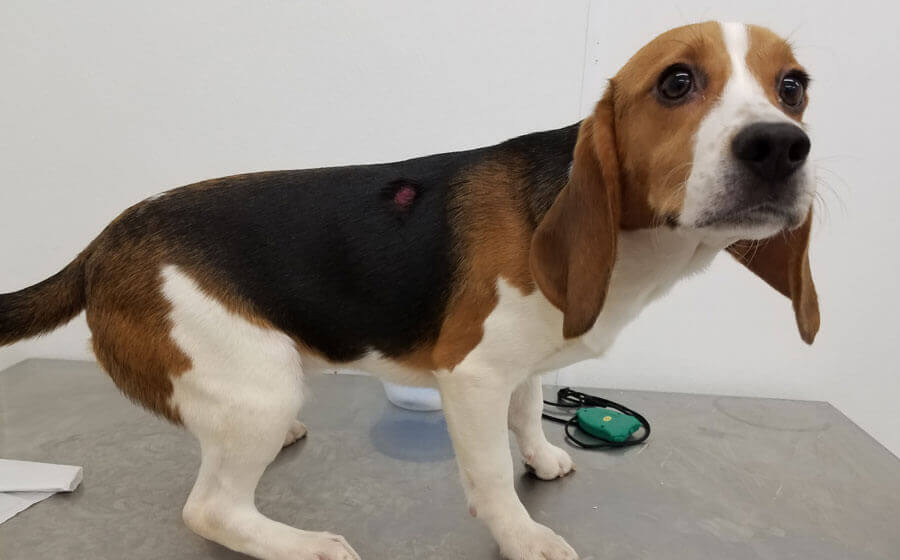
Want to Learn More About the History of Animal Testing?
Be sure to check out PETA’s interactive online timeline, “Without Consent.” It explores the troubled history of animal testing and challenges what we’ve been told for decades is normal.
It’s speciesist to believe that animals in laboratories don’t feel emotions or experience pain. Animals used in experiments are no different from the cats and dogs with whom many people lovingly share their homes, yet they are afforded few—if any—of the same protections or considerations. As a result, more than 100 million animals suffer and die in the U.S. every year in cruel chemical, drug, food, and cosmetics tests as well as in medical training exercises and curiosity-driven medical experiments at universities.
What You Can Do for These Animals
Now that you’ve learned more about the history of animal testing, discover what you can do for animals in the present day. PETA makes it easy to take action for animals suffering in cruel and useless experiments like the ones described above. It only takes a minute using your phone or computer, so what are you waiting for?
From PETA and executive producer Bill Maher, the new docuseries ‘The Failed Experiment’ exposes what most people don’t know about experiments on animals.

